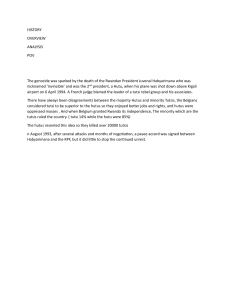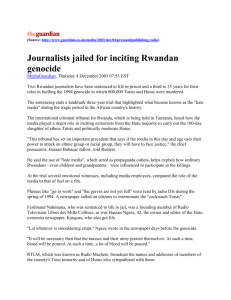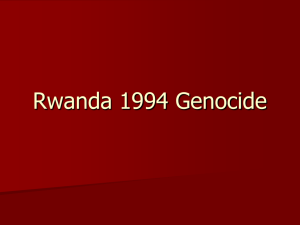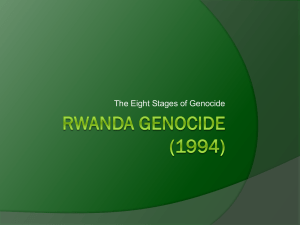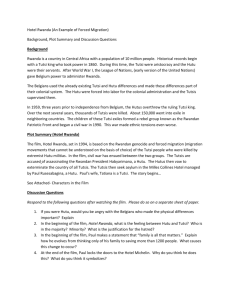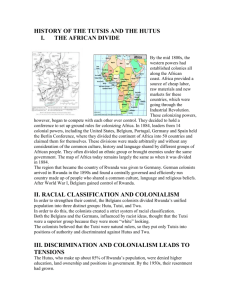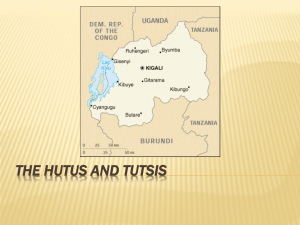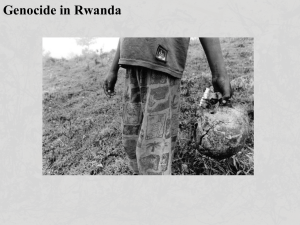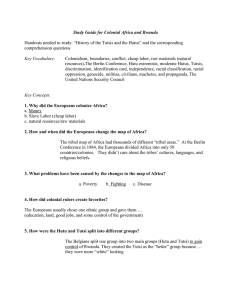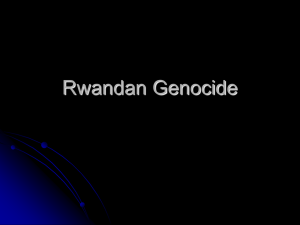genos
advertisement
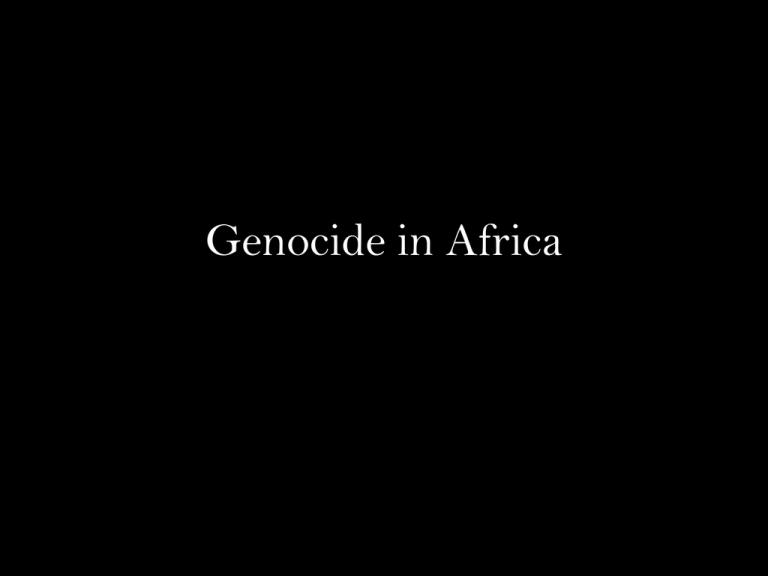
Genocide in Africa What is Genocide? Geno: (Greek: genos) Race or Tribe Cide: (Latin: cide) Kill Any of the following acts committed with intent to destroy, in whole or in part, a national, ethnical, racial or religious group, as such: • Killing members of the group • Causing serious bodily or mental harm to members of the group • Deliberately inflicting on the group conditions of life calculated to bring about its physical destruction in whole or in part History of Genocide in Rwanda Rwanda is a small country in central Africa. It is the most densely populated country in Africa. It is populated by two major ethnic groups: the Hutus and the Tutsis. In 1994, after a long process of planning and preparation, the Hutu majority launched an intense period of systematic killings of friends, neighbors and schoolmates, murdering mostly Tutsis and some moderate Hutus. In less than one hundred days, nearly one million people were killed. That is nearly twice the entire population of Washington, DC. History of the Conflict The colonization of Africa had a severely negative impact on both the continent and its people. By the mid 1800s, the western powers had established colonies all along the African coast. Africa provided a source of cheap labor, raw materials and new markets for these countries, which were going through the Industrial Revolution. These colonizing powers, however, began to compete with each other over control. They decided to hold a conference to set up ground rules for colonizing Africa. In 1884, leaders from 14 colonial powers, including the United States, Belgium, Portugal, Germany and Spain, held the Berlin Conference where they divided the continent of Africa into 50 countries and claimed them for themselves. These divisions were made arbitrarily and without any consideration of the common culture, history and language shared by different groups of African people. Results of the Berlin Conference (1884) As a result, two things occurred: • people of common ethnic groups were separated by arbitrary national borders And • warring ethnic groups were brought under the same government. The map of Africa remains largely the same as when it was divided in 1884 - a major source for many of the continent’s conflicts today. Effects of the Berlin Conference continued The region that became the country of Rwanda was given to Germany. German colonists arrived in Rwanda in the 1890s and found a centrally governed and efficiently run country made up of people who shared a common culture, language and religious beliefs. After World War I, Belgium gained control of Rwanda. Belgian colonists in Rwanda Rwandan culture and schools before colonization Control under the Belgians In order to strengthen their control, the Belgian colonists divided Rwanda’s unified population into three distinct groups: Hutu, Tutsi, and Twa. In order to do this, the colonists created a strict system of racial classification. Both the Belgians and the Germans, influenced by racist ideas, thought that the Tutsi were a superior group because they were more “white” looking. The size of the nose and the color of the eyes were factors that determined whether a person was classified as Hutu, Tutsi or Twa. Colonialism leads to resentment The colonists believed that the Tutsi were natural rulers, so they put only Tutsis into positions of authority and discriminated against Hutus and Twa. The Hutus, who make up about 85% of Rwanda’s population, were denied higher education, land ownership and positions in government. By the 1950s, their resentment had grown. In 1959, violence between the Tutsi and Hutu erupted. Hutus overthrew Tutsi rule, declared an independent republic and elected the first Hutu president, Greg wa Kayabanda. Mass killings of Tutsis occurred during the transition to Hutu rule, hinting at things to come. The Hutu-led government used the same system of racial oppression that existed during colonialism, except that now they were in control. Even though the Hutus had suffered from this identity classification, they kept it in order to use it against the Tutsi who had once used it against them. Rising tensions based on racial divisions and the oppression of some groups of people set the stage for the horrific events that occurred in 1994. Hutu officials began preparation to carry out a massive genocide of the Tutsi minority. They trained and armed militias and gave arms to civilians. They distributed lists of people who were to be targeted and killed. Messages of hate were broadcast over the radio, encouraging the killing of Tutsi and opponents to the Hutu regime. The messages portrayed Tutsis as evil cockroaches and rats. The killings began the night that Rwandan President Habyarimana was killed when his plane was shot down near Kigali Airport. The President’s own supporters, Hutu extremists, are believed to have orchestrated the attack in order to prevent the President from signing peace agreements although the exact circumstances have never been determined. Almost one million people were killed during 100 days of genocide. By April 6, 1994, tensions between the Hutus and Tutsis had come to a boiling point. Within hours of the Rwandan President’s plane crash on that day, an organized and systematic program for mass extermination was well underway. Every day, for over three months, Tutsis were hunted, tortured, and massacred on the streets, in their homes, in churches, and in schools. Military officials were not the only perpetrators; threats and calls for violence turned neighbor against neighbor, as civilians picked up machetes and guns and slaughtered each other. By the end of the murder campaign, almost one million Tutsis and moderate Hutus had lost their lives. In comparison, the population of Washington, D.C. is approximately 570,000. Imagine twice the entire population of Washington, D.C. being slaughtered over a period of three months – not by bombs or machine guns but by garden tools, kitchen knives, and machetes. The genocide formally ended when Tutsi-led troops overpowered the extremist Hutu militias. • http://www.hrw.org/en/node/87596
